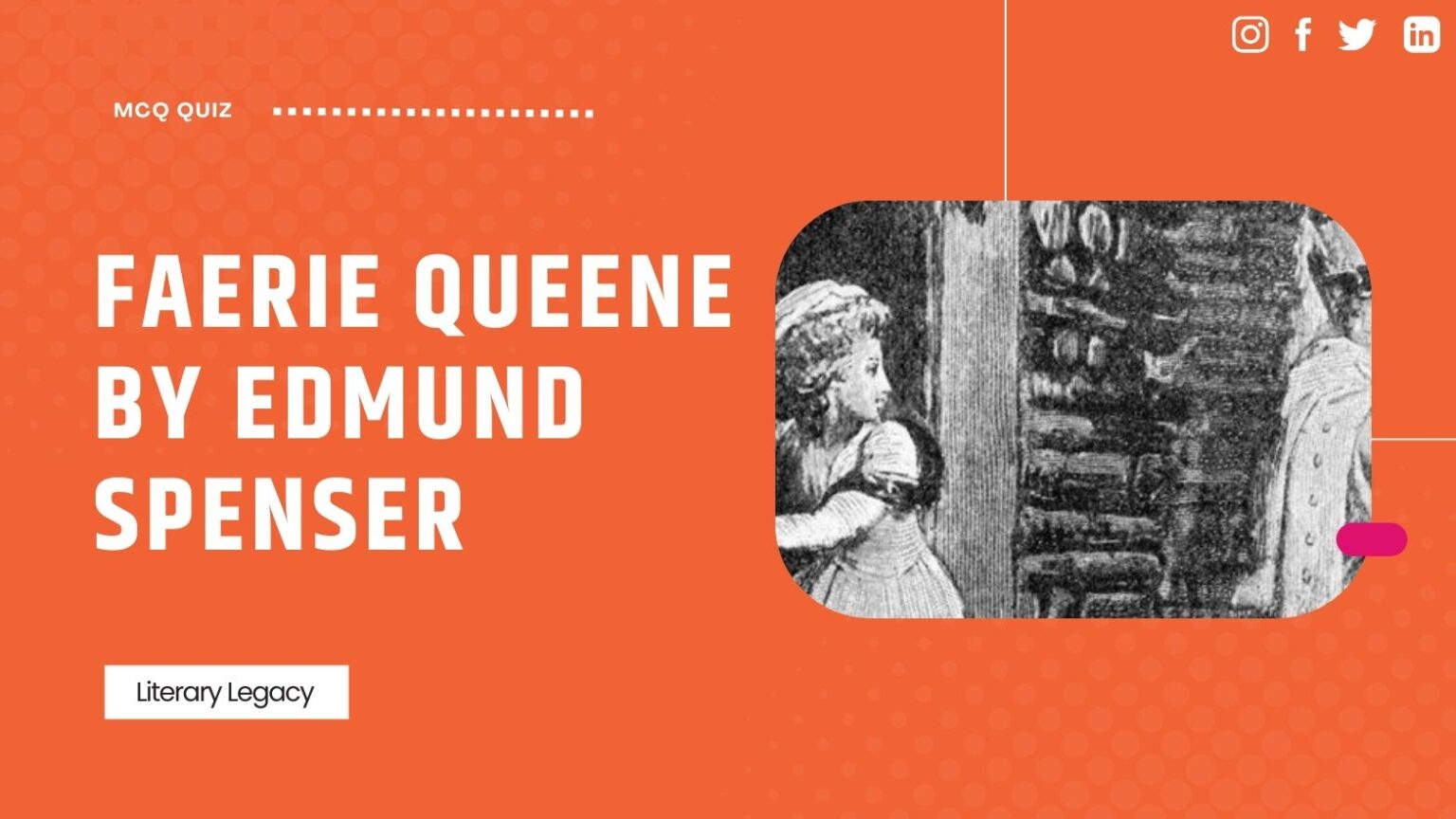1. What virtue does the Redcross Knight represent in Book I?
A) Integrity
B) Wisdom
C) Holiness
D) Courage
Answer: (C)
Holiness
The Redcross Knight symbolizes holiness in his journey.
2. Who is the main antagonist that Redcross Knight faces in Book I?
A) The monster Error
B) The dragon
C) Evil wizard Archimago
D) The sorceress Duessa
Answer: (B)
The dragon
Redcross Knight’s ultimate goal is to slay the dragon terrorizing Una’s parents.
3. What does Redcross Knight’s shield depict?
A) A white dove
B) A red Christian cross
C) A green cross
D) A golden lion
Answer: (B)
A red Christian cross
The shield is enchanted and features a red Christian cross.
4. In Book II, which virtue does Sir Guyon represent?
A) Temperance
B) Compassion
C) Bravery
D) Honesty
Answer: (A)
Temperance
Sir Guyon embodies temperance in his adventures.
5. Which character disguises himself to lead Redcross Knight astray?
A) Duessa
B) Archimago
C) Prince Arthur
D) Acrasia
Answer: (B)
Archimago
Archimago uses deception to mislead Redcross Knight into thinking Una is unfaithful.
6. What ultimately saves Redcross Knight from despair?
A) His shield’s magic
B) Una’s love
C) A holy house
D) Prince Arthur’s help
Answer: (B)
Una’s love
Una’s intervention brings him back from despair during his darkest moment.
7. What does Guyon encounter after meeting the dying Amavia?
A) Despair
B) The dragon
C) Acrasia
D) Archimago
Answer: (C)
Acrasia
Amavia informs Guyon about the witch Acrasia, who is a key figure in the story.
8. How long does the battle between Redcross Knight and the dragon last?
A) One day
B) Three days
C) Two days
D) Four days
Answer: (B)
Three days
Redcross Knight battles the dragon for a fierce three-day struggle.
9. Who helps protect Una when she is in trouble?
A) Prince Arthur
B) Redcross Knight
C) Sanfoy
D) Archimago
Answer: (A)
Prince Arthur
Prince Arthur comes to Una’s aid during her time of danger.
10. What does Redcross Knight need to do after marrying Una?
A) Defeat Archimago
B) Rest for a week
C) Fulfill his duties to the Faerie Queene
D) Travel with her
Answer: (C)
Fulfill his duties to the Faerie Queene
Despite marrying Una, Redcross Knight has obligations he must fulfill for the Faerie Queene.
11. What virtue does Sir Guyon primarily represent throughout his journey?
A) Justice
B) Temperance
C) Courage
D) Chastity
Answer: (B)
Temperance
Sir Guyon is known for his temperate personality, which helps him resist temptation and overcome challenges.
12. Which character is primarily associated with the theme of chastity?
A) Scudamore
B) Sir Guyon
C) Britomart
D) Arthegall
Answer: (C)
Britomart
Britomart is a unique character representing chastity, and she trains as a knight to find her future husband.
13. Who does Cambell kill during the tournament to find a suitor for his sister?
A) Triamond
B) Priamond and Diamond
C) Arthegall
D) Marinell
Answer: (B)
Priamond and Diamond
Cambell slays both Priamond and Diamond during the tournament, demonstrating his strength and courage.
14. What ultimately happens to Arthegall after he encounters Radigund?
A) He flees back to Britain
B) He becomes a tyrant himself
C) He defeats her and rescues Eirena
D) He is captured and imprisoned
Answer: (D)
He is captured and imprisoned
Arthegall is defeated and captured by Radigund, leading to his imprisonment until Britomart rescues him.
15. What challenge does Mutabilitie raise in Book VII?
A) A test of strength against Jupiter
B) A debate over virtue
C) A claim to rule heaven
D) A war against knights
Answer: (C)
A claim to rule heaven
Mutabilitie argues that she should rule heaven instead of Jupiter, but her challenge is ultimately unsuccessful.
16. Who helps Amoretta escape from the savage carle?
A) Sir Guyon
B) Britomart
C) Scudamore and Arthur
D) Timias
Answer: (C)
Scudamore and Arthur
Amoretta is rescued by Scudamore with the assistance of Arthur and his squire Timias.
17. Which knight does Britomart gravely wound during her adventures?
A) Radigund
B) Scudamore
C) Talus
D) Marinell
Answer: (D)
Marinell
Britomart gravely wounds Marinell, who had been warned to avoid women yet falls for the fair maiden Florimell.
18. What does Sir Calidore seek to defeat during his quest?
A) Evil sorcerers
B) The Blatant Beast
C) A giant
D) A dragon
Answer: (B)
The Blatant Beast
Calidore pursues the Blatant Beast, which poses a threat to the honor of noble knights and ladies.
19. How does Britomart first encounter Arthegall?
A) At Acrasia’s Bower of Bliss
B) While rescuing Eirena
C) In a vision from Merlin
D) During a tournament where they fight
Answer: (D)
During a tournament where they fight
Britomart and Arthegall meet and fight in a tournament, leading to a romantic recognition between them.
20. Which character does Britomart travel with as her companion?
A) Amoretta
B) Pastorella
C) Glauce
D) Florimell
Answer: (C)
Glauce
Britomart is accompanied by her nurse Glauce, who acts as her squire during her quest.
21. What is the relationship between Queen Elizabeth and the character of the Faerie Queene?
A) The Faerie Queene is a critique of Elizabeth’s leadership style.
B) The Faerie Queene is a literal representation of Elizabeth’s political ambitions.
C) The Faerie Queene serves as a virtuous stand-in for Elizabeth.
D) The Faerie Queene is portrayed as an adversary to Elizabeth
Answer: (C)
The Faerie Queene serves as a virtuous stand-in for Elizabeth.
The Faerie Queene symbolizes Queen Elizabeth’s virtue and serves as a flattering representation of her.
22. Which character in The Faerie Queene symbolizes British identity and is also notably a virgin?
Choices
A) Sir Guyon
B) Sir Calidore
C) Redcross Knight
D) Britomart
Answer: (D)
Britomart
Britomart represents British identity and virtue, paralleling Queen Elizabeth’s own chastity.
23. What unusual feature distinguishes Book II, Canto X of The Faerie Queene?
Choices
A) It serves as a commentary on modern politics.
B) It introduces characters from Greek mythology.
C) It features a lengthy retelling of British history.
D) It contains a fictional battle between mythical beasts.
Answer: (C)
It features a lengthy retelling of British history.
This section pauses the action to allow Sir Guyon to read a detailed account of British history.
24. How does Spenser blend myth and reality in his portrayal of British history?
Choices
A) He separates myth from history to avoid confusion.
B) He integrates both real history and mythology to enhance national pride.
C) He focuses only on factual events from historical records.
D) He entirely dismisses mythology in favor of realism.
Answer: (B)
He integrates both real history and mythology to enhance national pride.
Spenser mixes historical facts with mythological elements to foster a sense of British identity.
25. What purpose does Spenser’s portrayal of Queen Elizabeth serve in The Faerie Queene?
Choices
A) To depict her as a military leader.
B) To portray her as a flawed monarch.
C) To criticize her rule and question her decisions.
D) To glorify her and promote British nationalism.
Answer: (D)
To glorify her and promote British nationalism.
The flattering portrayals of Elizabeth help promote a sense of British nationalism throughout the poem.



